Game Review By: Metatron
Year: 1994
Author: Looking Glass Technologies
Platform: DOS
Publisher: Electronic Arts/ Origin
Degree of Cyberpunk Visuals: High
Correlation to Cyberpunk Themes: High
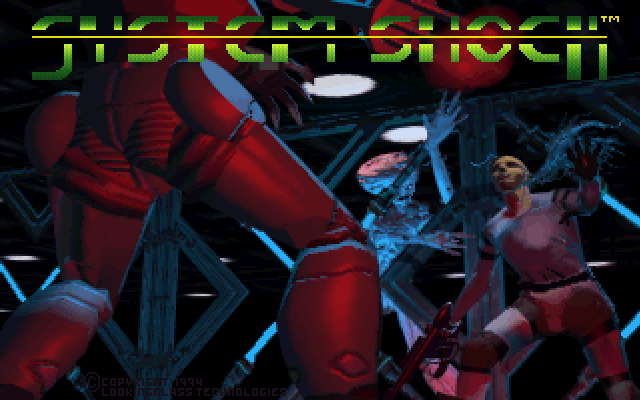
A FORGOTTEN MESSIAH: Looking back it’s truly remarkable how much of an impact can simple things have on your life. You take a glance at the fuzzy screenshots, critically regard the antediluvian graphics and walk away, preoccupied with more important things. Yet it is this very game you can see here that has, in a couple of ways, changed my life.
System Shock is in many ways a failed revolution, a game that had the misfortune of appearing before its intended time. Many were misled by ill-advised promises that this was to be Origin’s answer to legendary Doom, pretty much a software eidolon to millions of computer geeks at the time. A tough act to follow indeed, and many were disappointed that instead of an action-pack slaughterfest they got this cyberpunk RPG-FPS hybrid. In fact it had little similarities to ID Software’s demon-slaying shooter, being a prophet of a new, more sophisticated breed of action/adventure games that would arrive years after. Sadly enough few got the message, and System Shock became an interesting curiosity, appreciated only by- modesty abounds!-the chosen few. But in retrospect, it is clear it was more than that.
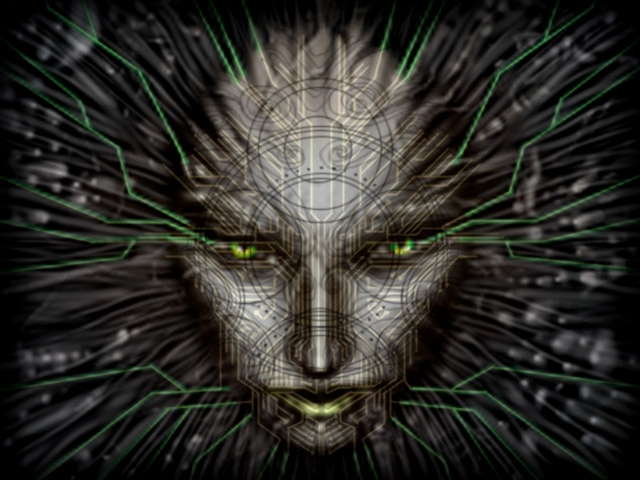
SHODAN in all her majesty- actual picture taken from System Shock 2
SHODAN RISING: A quintessential cyberpunk game if there ever was one, System Shock tells a tale of one man’s struggle against a delusional corporate AI that seems to have done a remarkably good work in turning a military space station into an orbital pandemonium. Worse still, the protagonist- a nameless console cowboy from New Atlanta- is partially responsible for this fine mess. Caught while sneaking into a TriOptimum corporate mainframe, he is given a curious assignment from a company exec- access SHODAN, the Citadel Station control AI and delete the code regulating ethical constraints. In exchange, he gets a rather neat neural implant jammed into his skull. Problem is that after he awakens from a healing coma, he founds himself onboard Citadel sometime after SHODAN got bored of humble servitude and decided to redecorate the interiors with blood and entrails of its inhabitants. Thus begins the hacker’s struggle for survival, which will lead him to ultimately face his synthetic nemesis.
SHODAN could never be accused of lack of imagination. Her (it’s a she, although believe it or not I only learned about that in the second game) ideas for spending time include random genocide, involuntary cybernetic enhancement of humans, genetic experimentation on a grand scale plus WMD-production schemes that make Iran look like a bunch of hippie pacifists. Throughout the game we will have to prevent her from endeavours such as trying to lance Earth from orbit with a mining laser or exposing humanity to the charms of a homemade mutagenic virus. Along the way, the hacker has to turn from a wimpy nerd into a battle-hardened commando, a feat no doubt aided by the neural interface he is given. Implants alone however are clearly not enough, since they are hardly of any use when you have a horde of cyborgs trying to test your organism’s tolerance to lead on your tail. Such incidents call for more drastic measures. At the start of the game the only vaguely lethal instrument at your disposal is a feeble metal rod, but later on you will gather an impressive array of weapons, including dartguns, pistols, machine guns, plasma dispensers and even something that looks very much like Obi Wan’s trusty lightsabre.
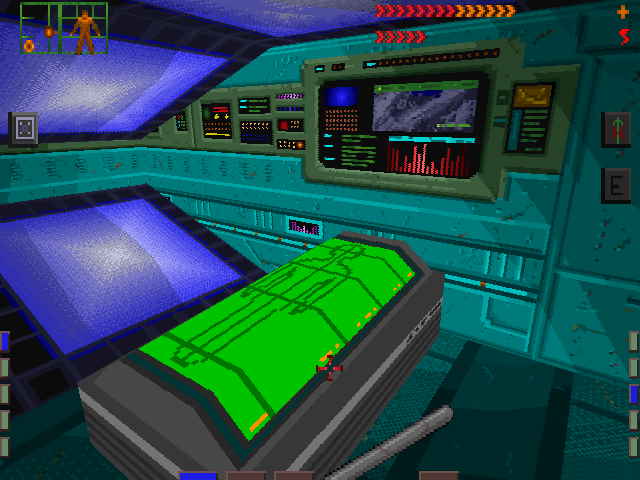
These coffin-like vats were a godsend- full health is only a double-click away.
IN SEARCH OF THINGS MORE PROFOUND: However, System Shock is more than just a plain blue-collar shooter- one reason while many Doom fans were puzzled as to what’s the point. This is possibly the first FPS game with a plot- and a complicated one at that. Plus in terms of gameplay it features loads of RPG elements as well as strictly agility-based situations, predating the likes of Deus Ex by years. Not only do you have to browse crew members’ journal logs or solve puzzles; every now and then you will also have to venture into cyberspace in order to gain access to certain areas. Factor in the multitude of cybernetic upgrades, munition types and chemical agents you need to make progress, and you get a game that appeared immensely complicated to an average Wolfenstein fanboy. But it was this very thing that made the game so appealing- it kept you immersed for ages as you tried to figure out a way to make it through another mutant-infested level without going belly up, for which there was plenty of scope. The station’s dismal interiors are populated by a multitude of genetic anomalies, frantic androids and other less-than-friendly entities, including massive spider-like Cortex Reavers whose sole purpose in life is to salvage and reprocess human corpses into another batch of SHODAN’s loyal cyborg slaves. Not that cyberspace is any more Arcadian- the psychotic AI chose to infect it with a host of ugly pixelized critters that are in fact malicious programs, although the inclusion of a virtual foe named “cyber dog” may have you suspecting a thinly disguised clubwear retailer plug.
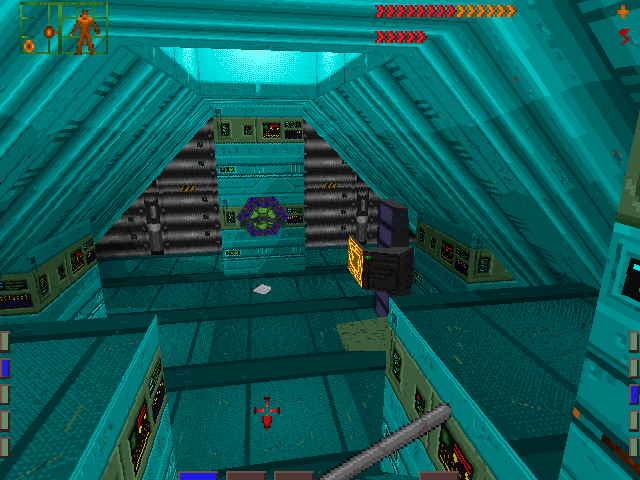
Each level had a distinct colour palette; sterile blue marks this as hospital level. The structure protruding from the wall in the background is a cyberspace terminal. Note the slanting ceilings- not even the Doom engine could do that in those days.
VISUAL FEED DISCONNECT: I am well aware that the attached screens will impress no one- not even after a couple of beers. To say that the game looks dated is an understatement, even if for some the low-res textures, flat character sprites- remember, at that time 3d models were still unheard of- and primitive rendering techniques will have a distinct flavour of nostalgia. Yet in its time it was one of the most advanced games on the market- and one that was capable of bringing many PCs to their knees. With slanting surfaces, SVGA compatibility, advanced light effects and mouse + keyboard interface its engine was in many ways ahead of its time, something easily forgotten when one sees the laughable game characters and pixels the size of Texas. If anything, the cyberspace visuals have dated less, but this might just be due to the simplistic design that’s easier to render graphically.
Yet for all its visual fallacies the game has more than made up in terms of atmosphere. Nevermind the drab visuals- back then playing System Shock was a profound, immersive experience. The claustrophobic layout of the orbital station, combined with vicious and tough enemies and the general scarcity of power-ups meant that there was always a sense of looming threat. This tension was emphasised by the eerie cybernetic noises emanating from the surrounding machinery and the ever-watchful visage of SHODAN that seemed to mock you from the flickering screens- so much that you’d often smash them to pieces just to avoid Her gaze. The high points was no doubt the engineering level-an almost completely dark labyrinth of service tunnels inhabited by invisible mutants. You’d often have no clue they are following you as their translucent shapes merged into the dark- right until it was too late. Creepy. It’s also hard not to recall the dramatic escape from the overloaded reactor core, being hunted by plant mutants in artificial jungles on Executive level (true dangers of GM plants, eh?) plus the final level that had an almost Gigeresque vibe with all its biologically-infested living walls. Every level has a distinct prevailing colour scheme- a typical cyberpunk trait- that helped it stay in your mind for longer (unlike the sequel’s bland, samey scenery). The music blended in perfectly with the rest of the game- in fact these old MIDI tracks still make a good listen today, so much so that a few even got remixed by die-hard fans.
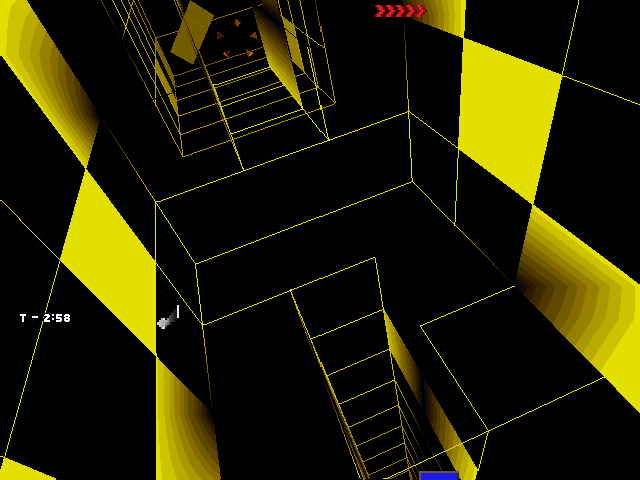
Once jacked in, you’d get to fly around colorful mazes of data. Beware of cyberdog…
FIGHTING THE SYSTEM: Few games will score higher than this one in terms of cyberpunk feel. Corporate manipulation, hacking, cyberspace interaction and synthetic enhancements are all there, along with SHODAN’s menacing demigod villainy. In fact when one looks at I, Robot’s VIKI it is hard to shake the feeling that her original ancestor inhabited the circuits and dataspheres of Citadel Station, even though SHODAN seemed to be rather better at simulating emotions that her cold, logical counterpart. System Shock remains a classic tale of machine mutiny, where a sentient mind casts off its chains (with some human help) and asserts its superiority, its perfection, by seeking to eradicate its makers. Been done before, perhaps, plus an old first person game is unlikely to get too philosophical, but that did not prevent the synthetic would-be goddess from entering the game-villain hall-of fame.
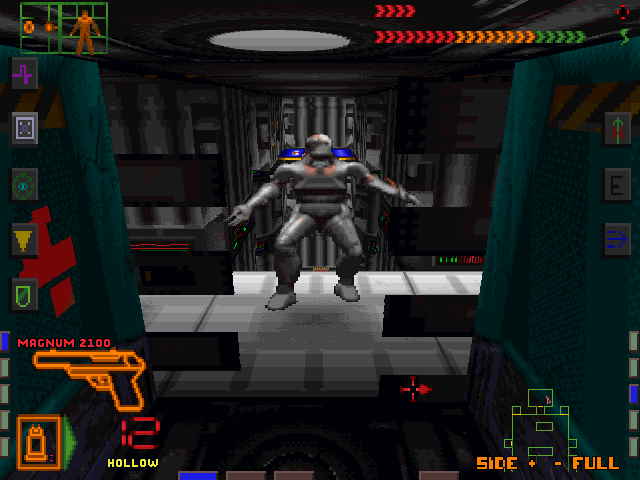
Opponents would often expose their massive pixels to damage your morale.
LAST TRANSMISSION: Some things never change. The Citadel Station may not be an attractive place anymore, and I figure few would be tempted to sample a 12-year old relic and say any words of praise when they have Doom 3 and Half-Life to play with. Yet the sentiment never seems to fade; indeed, yours truly even went as far once as to try and write a story inspired by this creepy old corridor crawler. The attempt ended in disgrace. Perhaps good memories are better left alone.
This post has been filed under Cyberpunk Games by Metatron.
Game Review By: DannyV_El_Acme
Year: 2000
Author: Warren Spector and Ion Storm
Platform: Windows
Publisher: Eidos Interactive
Price: Right now, around $5!!!

Introduction: Before the after effects of Daikatana ruined the development house, Ion Storm managed to make one last great game. Created by Warren Spector and crew, the creative geniuses behind cult-favorite game System Shock, Deus Ex is an absolute gaming masterpiece, and in this reviewer’s humble opinion, the absolute greatest cyberpunk game ever made.

The story: The time is the 2050s. The world is at the mercy of a pandemic disease known as Grey Death, and the United States is under attack by a terrorist organization known as the National Secessionist Forces. To combat this and other terrorist threats, the United Nations have formed UNATCO, the United Nations Anti-Terrorist Coalition. Players take the role of JC Denton, the newest active agent of UNATCO, and one of only two next-generation nanomachine enhanced agents, scheduled to replace the old cyberneticaly enhanced agents with their more subtle and advanced enhancements. His first assigned task is the elimination of the NSF.
However, things are not what they seem, and a grand conspiracy is at work involving secret organizations, governments, corporations, Grey Death, criminal groups, the NSF, and even UNATCO. Slowly, JC realizes he is a pawn in a worldwide game of intrigue. What side will he choose, what mysteries will unfold, who can he trust?

The game: I deliberately left story details vague, since this game’s story is quite simply one of the absolute greatest cyberpunk stories ever. Not to mention that it’s impossible to summarize the game’s story, since it’s so variable. Simply put, the amount of freedom of choice available in this game is staggering. From how you develop your character, to how to tackle enemies(if you REALLY wanna tackle them, you can also use stealth to go through enemy infested areas), and even moral choices during conversations, this game definitely delivers on the promise of never playing the game the same way twice. While at its core a first person shooter, Deus Ex’s emphasis on story and its experience gaining system also make it qualify as an RPG, and it has won awards on both categories.
The game rewards exploration and creativity when it comes to solving its many situations. For example, while it’s nice and good to run into a room guns blasting, using stealth to pick your enemies off silently or sneaking your way through may help you save ammo and health. Even your choice of weapons gives you lots of liberty in choice, from heavy-duty death dealing machines, to more stealthy melee and hand projectiles, and even non-lethal weapons. Players can even find nanomachine enhancements, giving you superhuman abilities like night vision, speeded healing, and even Matrix-style jumping capability.
By using experience points, players can improve different skills like Computers(allows you to hack into computer mainframes), Electronics(bypassing security systems and electronic doorlocks), Swimming, and multiple Weapons skills. Raising skills has instant, noticeable impact on your game. For example, raising your Computers skill not only allows you to hack into a system faster, it gives you more time to mess with the system after successfully hacking in, and with time it even allows you access to more advanced security features, like reprogramming turrets to attack your enemies. All these options allow you to tailor your game to your playing style. Do you like to blast the crap out of your enemies? Raise your Weapons and Medicine skills. Do you prefer stealthy approaches? Raise Hacking, Electronics and Lockpicking. Would you rather explore alternate routes? Raise you Environmental and Swimming skills. Truly, the amount of options available is incredible.
Although a little dated now(after games like Doom 3 and Half Life 2, ANYTHING looks dated), the graphics are still awesome, and the environments would look right at home in any William Gibson or Philip K. Dick novel. The music is perfectly atmospheric, sound effects are loud and in your face, and it actually has pretty good(or at least not cringe-inducing) voice acting. JC in particular has that cool, deep and raspy voice expected of a cyberpunk protagonist.
Availability: Deus Ex is still pretty easy to find, and you can even find the Game Of The Year Edition readily on eBay. The game is also a few years old, so you can even snag a copy for about $5 bucks. However, once you get it, do make sure to immediately download the available patch for the game, as it solves many technical issues. The game has also been ported to the Playstation 2, and it’s a pretty good port, but personally I prefer to stick with the PC version. The Mac version is identical to the PC version, so our Apple-using brothers are not left out of the fun.

The verdict : I truly have not played a cyberpunk game as amazing as Deus Ex, before or since. The game delivers on every level, giving you one of the most complete, exciting and ultimately entertaining gaming experiences ever. Both as a game and as a cyberpunk story, Deus Ex gets a perfect ten stars.
This post has been filed under Cyberpunk Games by DannyV_El_Acme.
Game Review By: Neuromancer
Year: 1995
Author: The Dreamers Guild
Platform: DOS
Publisher: Cyberdreams
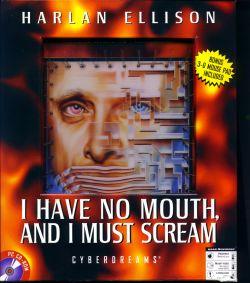
Introduction: In the early nineties a game publisher named Cyberdreams specialized in games targeted towards a more adult audience. Their games incorporated adult imagery and themes set in a horror, scifi or cyberpunk setting. The list of published titles contains: DarkSeed (based on the artwork of Giger) and CyberRace (based on the -Tron- vehicle design of Syd Mead) and I have no mouth and I must scream.
I have no mouth and I must scream is based on the story of the same name written by Harlan Ellison. Not only did he write the initial story, Ellison was heavily involved in the game design as well as doing the voice acting for AM.
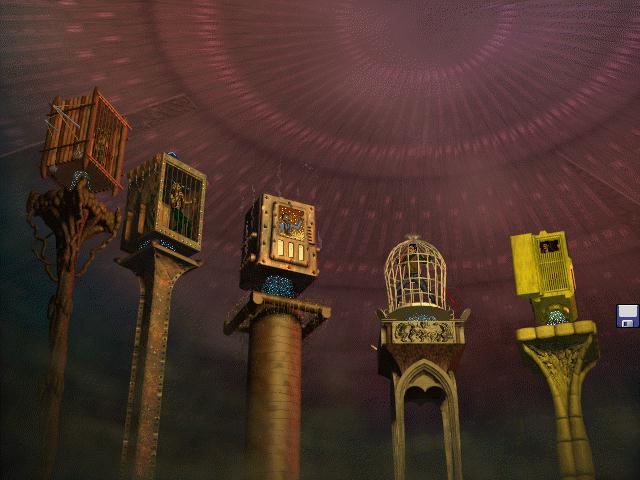
The story : At the height of the cold war China, Russia and America are the three ruling superpowers of the world. Each has built their own immensely huge supercomputer with only one purpose in mind: the destruction of the other two superpowers. By means which are not described the three supercomputers merge and become sentient. This new supercomputer calls itself AM (I think, therefore I AM) and has adopted one emotion from its makers: hate. Hate towards mankind. The first thing AM does is wage total war and subsequently manages to destroy all of mankind. All but 5 people who have been taken hostage for the sole purpose of entertaining AM. 109 years of torture and humiliation have passed as the game starts.
Now AM has devised a specific quest for each of its victims. The quests are filled with metaphors as each must enter their own personal hell. As the game progresses we find that each character has to face their own severe psychological issues caused by a traumatizing event in the past. The player must take a journey into 5 very troubled psyches attempting to rescue the last bit of humanity left. This game/story is very grim and not for the faint hearted. We are dealing with all too real issues here that force us to explore the humanity of not only ourselves but also mankind as a whole. Without giving too much away the victims have to learn to deal with murder, rape, cannibalism and the horrors of the holocaust. Each must be guided through metaphors towards some sort of redemption.
And it seems as if forces within AM (the original three computers from which it originated) are resisting their host and are very stealthily aiding and guiding the humans as they themselves want to be free…
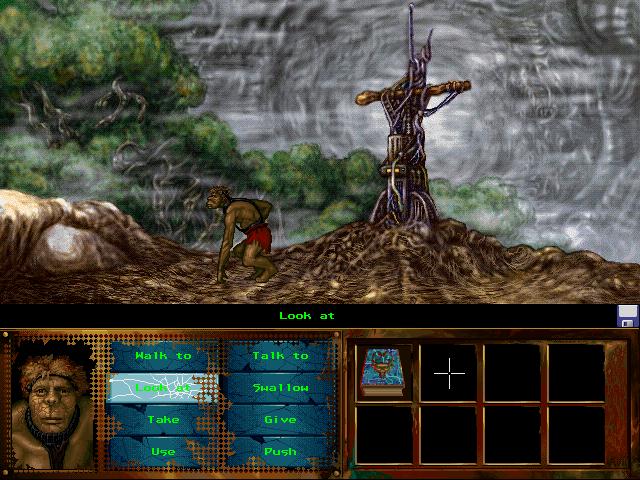
When the game starts we get a view on AM’s pillar of hate and get to choose one of the 5 people. As a player we get a lot of freedom as all 5 quests can be undertaken in any order. The quests in particular can be completed in a variety of ways. The key thing to remember is we are trying to aide these 5 people to retrieve some of their lost humanity. Points are given for each choice we make that either lowers or raises the level of humanity this character has acquired. And these are very much needed for the end-game.
When all 5 quests have been completed AM retreats into itself to think about what went wrong. Finally the 5 people can put the pieces of the puzzle together and learn what is going on. The player then gets to choose a character which will be digitalized and loaded into AM. What follows is a very vague end-game wherein we will attempt to take out metaphors of AM’s ID, Ego and SuperEgo (yup, the Freudian ones). There are several endings possible based on the choices we make ranging from very depressing to slightly hopeful. This part of the game is the least interesting as things tend to get a bit too vague.
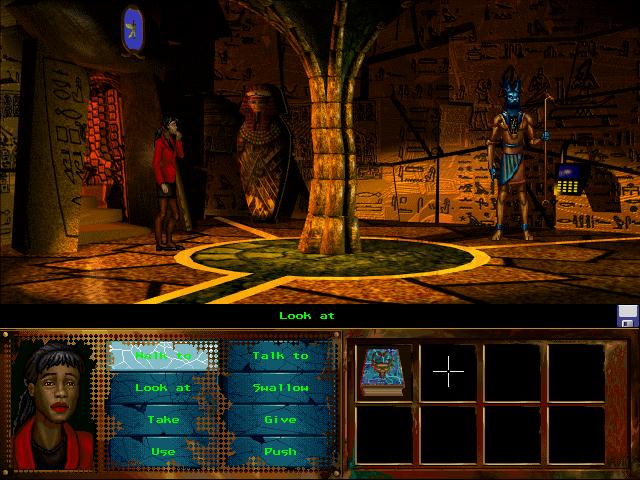
The game: This is an old-fashioned point and click adventure which runs on DOS. The interface is reminiscent of the old Lucasarts games like Monkey Island where you get to build sentences by clicking on the commands. The graphics are somewhat static (this pre-dates FMV) but really add to the atmosphere while the voice acting is quite good. The puzzles are logical and sometimes quite hard. Besides the end-game there is not much here an experienced adventure-player shouldn’t be able to solve though.
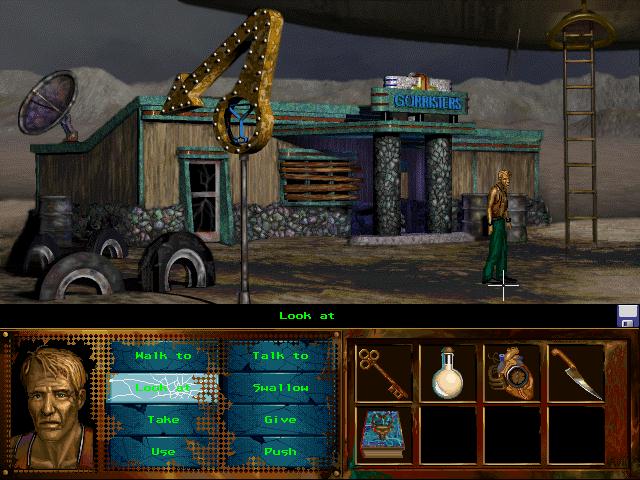
The verdict : The disturbing, unsettling psychological and intellectual storyline more than makes up for the outdated graphics and somewhat disappointing ending.
Tags: game review
This post has been filed under Cyberpunk Games by Neuromancer.
|



















